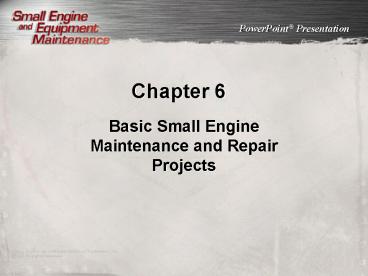Basic Small Engine Maintenance and Repair Projects - PowerPoint PPT Presentation
1 / 28
Title: Basic Small Engine Maintenance and Repair Projects
1
Chapter 6
- Basic Small Engine Maintenance and Repair Projects
2
- Engine oil used in small engines should be
changed every 25 hours of operation or once per
season.
3
(No Transcript)
4
- Used oil and soiled rags should be disposed of in
accordance to local environmental statutes.
5
- Several different steps are required to properly
remove debris from a small engine.
6
- Accumulated grease can be removed from OPE by
using a degreasing agent and a pressurized water
hose.
7
- A spark plug gauge is used to adjust and measure
the gap between two electrodes at the tip of a
spark plug.
8
- A spark tester is used to test the ignition
system of a small engine.
9
- A visible spark is present in the window of the
tester when the ignition system is functioning
properly.
10
- A spark plug is tested for spark miss after the
ignition system proves to function properly.
11
- Dual-element air cleaners are available in a
variety of designs.
12
- An attachment screw must be loosened to remove
the air cleaner assembly cover on most small
engines.
13
- Foam air-cleaner elements must be saturated with
engine oil prior to installation.
14
- Dual-element air cleaners contain foam precleaner
and a pleated paper element.
15
- Many precleaners have installation instructions
printed directly on the surface.
16
- Air-cleaner cartridge housings should be cleaned
with a clean, dry cloth instead of solvents or
compressed air.
17
- A muffler that is attached to an engine with
bolts can be removed by loosening the bolts with
a socket wrench.
18
- A muffler that is screwed directly into an
exhaust port should have penetrating oil applied
to the screw threads prior to removal.
19
- A threaded muffler can be removed by grasping
with slip-joint pliers and rotating
counterclockwise.
20
- Hard soot accumulation in a muffler can be
removed by tapping the muffler body with a rubber
mallet or on a hard surface.
21
- Some lawn and garden tractors are equipped with
mower decks that can be easily removed or
installed using a quick-disconnect mechanism.
22
- Shear pins are designed to reduce component
damage by fracturing when the driven member of a
rigid system requires more power than a disc or
coupling is able to provide.
23
- Two-stage snow throwers typically have skid shoes
to help provide smooth movement of the snow
thrower along uneven surfaces.
24
- Testing engine compression verifies the maximum
power output of each piston stroke.
25
- Testing a crankcase breather ensures that
crankcase gases are properly vented.
26
- When preparing a lawn mower engine for long-term
storage, the moving components should be
lubricated lightly with spray lubricant. Each
lubricated component should then be actuated to
spread the lubricant evenly into the moving parts.
27
- Prior to long-term storage, the belt drive
systems of mower deck blades should be examined
for worn, scorched, or misaligned belts.
28
- There is often an idler pulley connected with
linkage to the clutch pedal of ride-on lawn
mowers.































